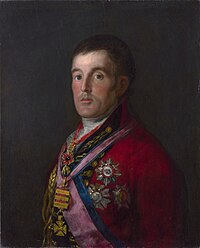|
Army Gold Medal
The Army Gold Medal (1808–1814), also known as the Peninsular Gold Medal, with an accompanying Gold Cross, was a British campaign medal awarded in recognition of field and general officers' successful commands in campaigns, predominantly the Peninsular War.[1] It was not a general medal, since it was issued only to officers whose status was no less than that of battalion commander or equivalent.[2] BackgroundNaval Gold Medals had been awarded since 1794 to captains and admirals who had served in specified successful naval actions, admirals' medals being larger.[3] In 1806 a special gold medal was presented to British Army majors and above who had taken a key part in the Battle of Maida. This medal, 1.5 inches (38 mm) in diameter, shows the profile of King George III on the obverse with a reverse design incorporating Britannia and the Sicilian triskeles.[2] A general campaign medal for the Napoleonic Wars, awarded to all British troops irrespective of rank, would only be established in 1847.[4] AwardsThe Army Gold Medal was established in 1810 to reward service at Napoleonic War battles since 1808. Like the Maida Gold Medal, it was awarded only to majors and above and, like the Naval Gold Medal, it was awarded in two sizes, with the larger to senior officers. When the Army Gold Medal was first established, a new one was issued for each action. In October 1813, to prevent a proliferation of awards to one recipient, an order was created instructing that only one medal be worn, with a ribbon clasp denoting the battle concerned for any further award. The fourth award was to be marked by a Gold Cross, replacing the earlier medals, with the names of each of the four battles on the arms of the cross. Again, clasps for attachment to the ribbon of the cross were presented for any successive awards.[5] The award could be made posthumously, and sent to the officer's family.[5] The total number awarded were:[6][7]
Six or more claspsThe highest award was earned by the Duke of Wellington: a Cross with nine bars for a total of 13 actions.[8] It can be viewed on his uniform in the basement at Apsley House.
AppearanceThe medal came in three styles, laid out below:[6]  The Large Gold Medal, was restricted to general officers. The Small Gold Medal was awarded to officers between the rank of major and colonel.  The Gold (or Peninsular) Cross was awarded to those who earned four or more gold medals, which it replaced. Worn around the neck, it is an ornamental cross pattée 1.5 inches (38 mm) across, with a proud lion at its centre and the four qualifying actions embossed on its arms. The obverse and reverse are the same. Any further actions were marked with a clasp. The Clasps were of a common pattern for all awards, with the name of the battle within a wide laurel wreath frame. The Ribbon for all the awards was broad crimson with blue borders, 1.75 inches (44 mm) wide. This ribbon design had been used for the Maida Gold Medal and would later be used for the Waterloo and the Military General Service Medals and the Distinguished Service Order. Naming. All awards had the name of the recipient engraved on the rim.  A Gold Collar and Cross was awarded to Duke of Wellington and to Viscount Beresford. This cross was of a similar design to the Army Gold Cross, but with a winged figure of Victory at its centre, with suspension from a chain of alternate lions and Union Flag oval medallions. The Gold Collar and Cross was a separate and additional award to the Army Gold Cross.[10] DiscontinuationFollowing the Peninsular War, award of the gold medals and Crosses was discontinued when would-be recipients became eligible for Order of the Bath on its restructuring to three classes.[11] In 1847 the Military General Service Medal (MGSM) was authorised, to be retrospectively awarded to all surviving veterans of the campaigns, irrespective of rank. Holders of the gold medals, crosses or additional clasps were not eligible to claim identical clasps on the MGSM.[11] The eligible battles and campaigns for the MGSM were identical, with the addition of Egypt. The design of the cross is very similar to the later Victoria Cross[12] and is considered to have provided the inspiration.[13] ClaspsAwards, both medals and clasps, were made for the following 27 battles and campaigns:[14]
 The Battle of Maida in 1806 was commemorated by a gold medal of different design. See alsoNotes
References
External links |
|||||||||||||||||||||||||||||||||||||||||||||||||||||||||

